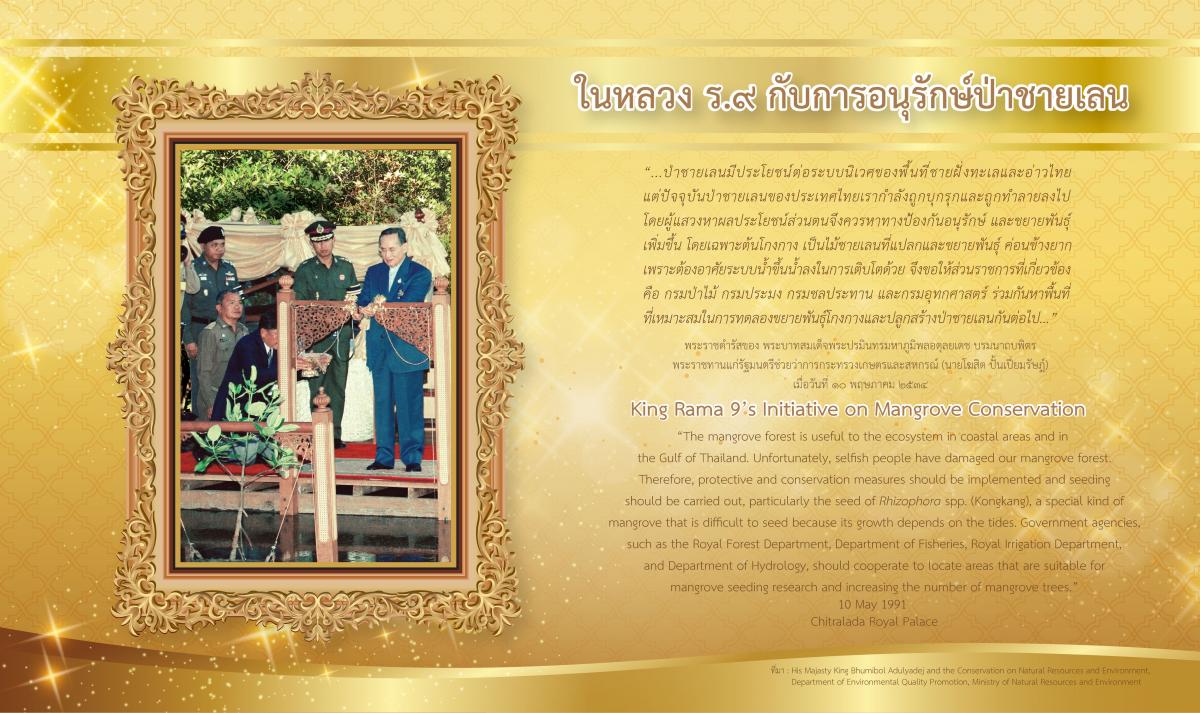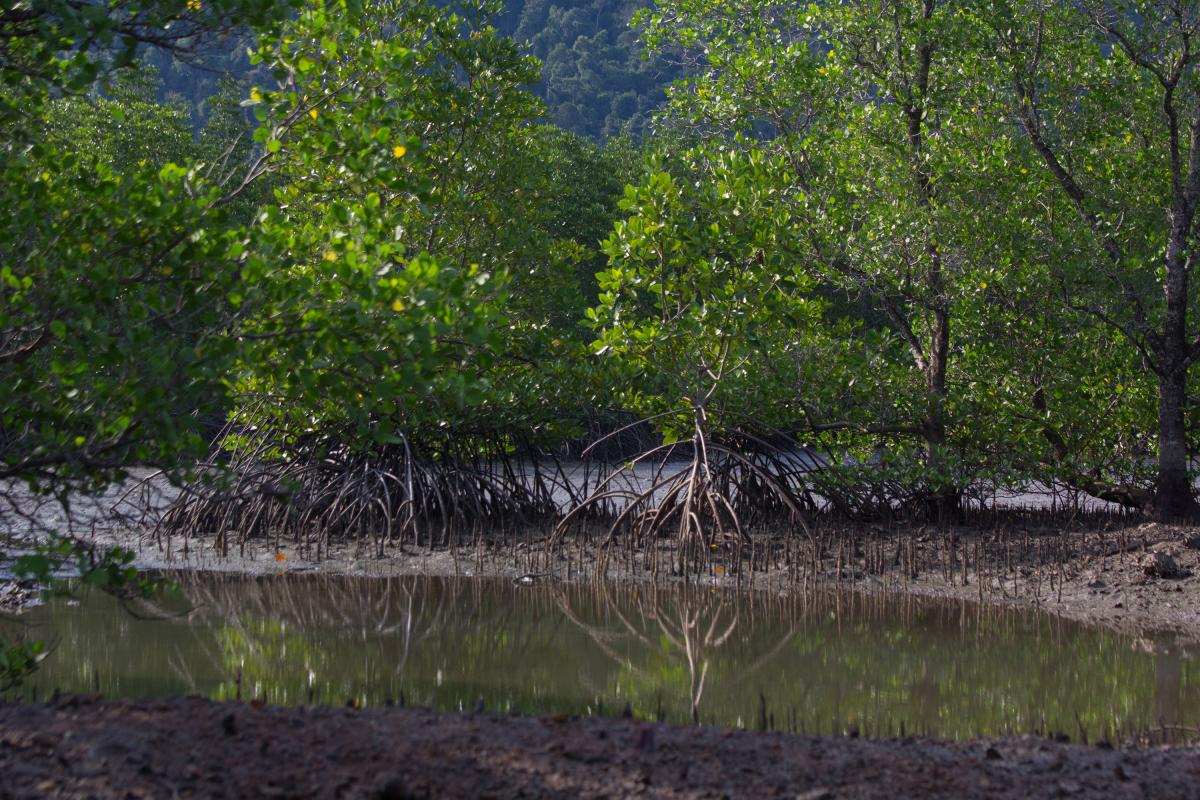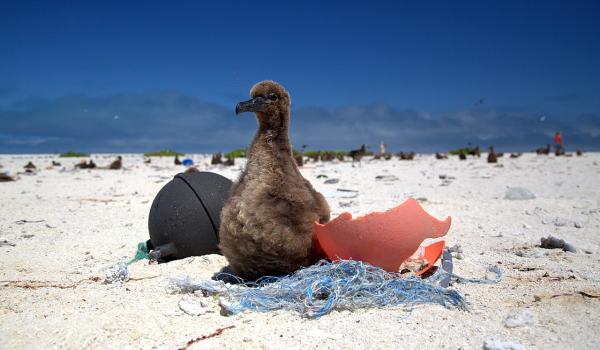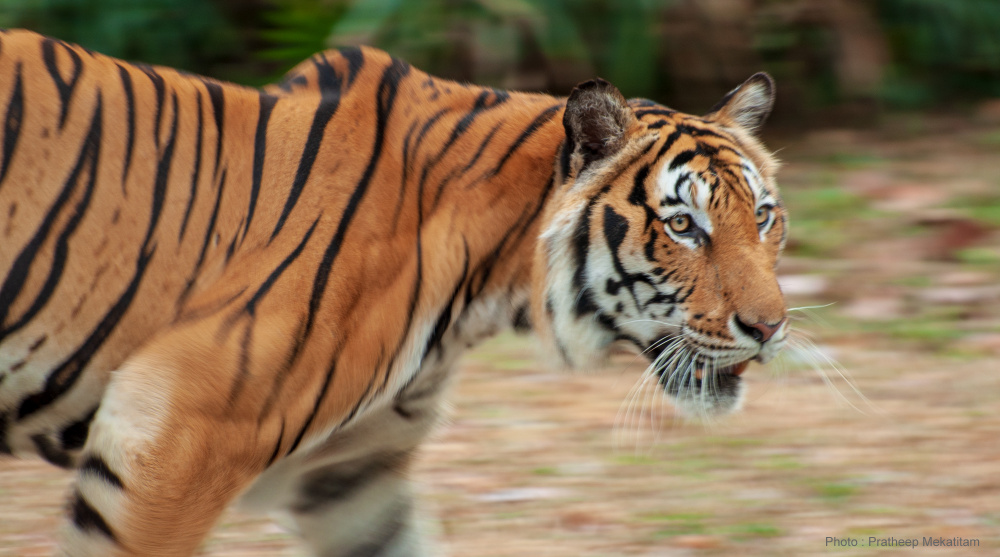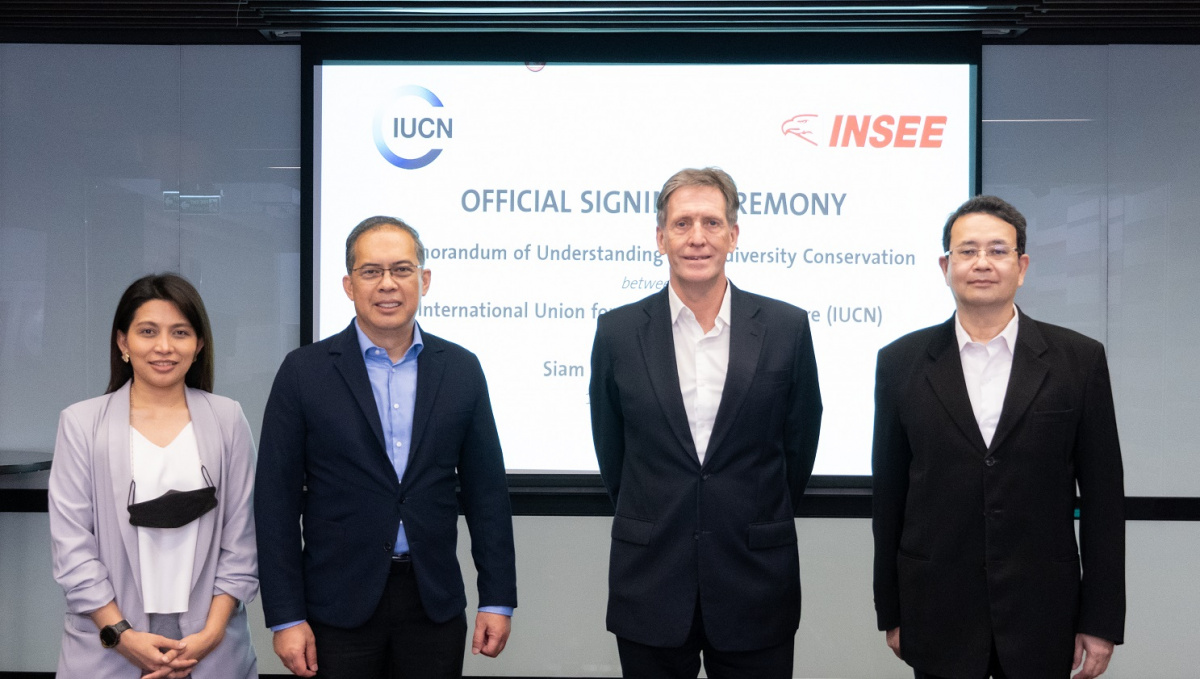Thailand celebrates its first National Mangrove Forest Day
On 10 May 1991, His Royal Highness King Rama 9 first addressed the importance of mangroves, marking Thailand’s recognition of the values of mangrove forests in the country. This history has prompted the Cabinet to recently approve a resolution, declaring 10 May of each year as the “National Mangrove Forest Day.”
 Photo: Art4Nature
Photo: Art4Nature
Mangroves are trees or shrubs that can grow in waterlogged, saline environments. Mangroves thrive in the tropics where the ocean meets the land; they grow in thickets that look like a jungle gym. Visible roots everywhere, special prop roots grow out of trunks and branches and descend into soil below the water. These roots make a kind of web, curving, twisting, and arcing.
 Photo: Siriporn Sriaram/IUCN
Photo: Siriporn Sriaram/IUCN
Threats and Benefits
Mangroves are threatened by human activities in many ways. Globally, loss of mangrove forests is 3 to 5 times higher than that of terrestrial forests. The rate of degradation and destruction is estimated to be about 1 % per year. Since 1980 it is estimated that 20 - 35 % of mangrove forests have been lost globally. From 1961 to 1996, Thailand lost about 56% of its mangrove forests due to the expansion of shrimp and salt farms. They are deforested to make room for shrimp farms and other forms of aquaculture, as well as for their wood. Mangrove forests depend on the presence of freshwater and can die when dams and other developments stem the flow of rivers. Other threats include agriculture and land use changes, pollution, sedimentation, and climate change.
The destruction of mangrove forests is responsible for about 10% of global CO2 emissions caused by deforestation – 240 million tons of CO2 per year. When we think of carbon capture and we should think of the mangrove forests instead of the tropical rainforests.
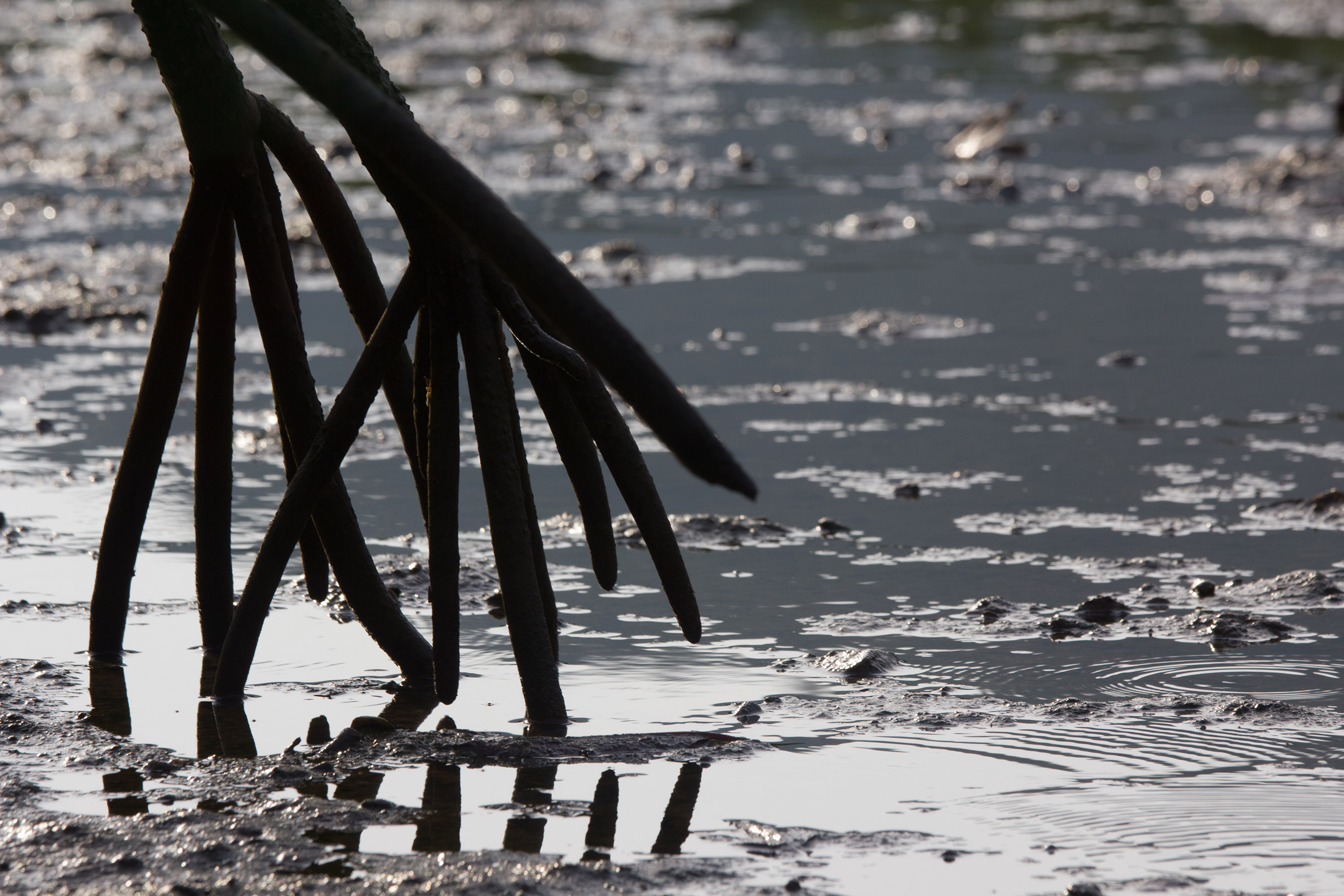 Photo: Siriporn Sriaram/IUCN
Photo: Siriporn Sriaram/IUCN
Blue carbon ecosystems, those systems in coastal areas including mangroves, seagrasses and tidal marshes, can be many times more efficient than terrestrial ecosystems at storing carbon. Mangroves are natural carbon-scrubbers, taking CO2 out of the atmosphere and packing it away, for millennia or more, in their rich soils. It is estimated that mangroves store 3 to 4 times more carbon than tropical forests. A new study indicates that previous estimates have been low and that mangrove soil held around 6.4 billion metric tons of carbon in 2000.
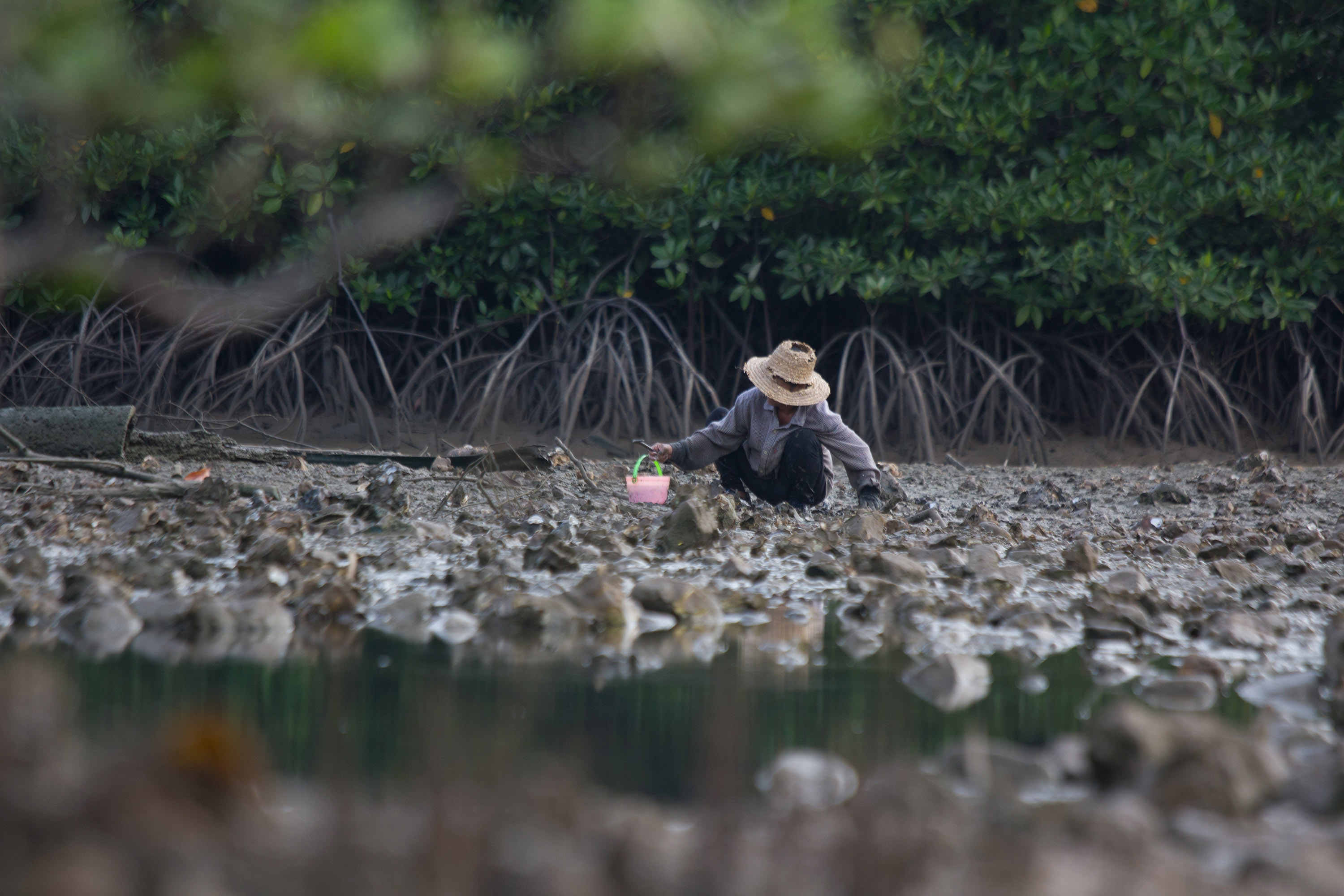 Photo: Siriporn Sriaram/IUCN
Photo: Siriporn Sriaram/IUCN
Wetland forests provide many other benefits to coastal communities. They act as storm barriers, protecting inland areas from flooding and erosion by dissipating the energy of big waves. They help filter a wide variety of water pollutants, and trap excess sediments. They help coastal economies by providing fish nurseries and food production.
In Thailand for example, according to a study done by United Nations Environment Programme (UNEP), the value of mangroves has been estimated to 3.5 million dollars per sq. km per year. Mangroves are estimated to be worth at least US$1.6 billion each year in ecosystem services that support coastal livelihoods and human populations around the world (www.thebluecarboninitiative.org).
For businesses, degrading ecosystems present several significant risks including disruptions to operations, reduced production capacity, increased competition for resources, and increased levels of public scrutiny and government regulation. Many businesses, large and small, are already reaping the benefits of strategic investments in coastal sustainability.
Enhancing mangrove conservation efforts
Protecting mangroves globally, nationally, and locally takes a concerted effort on part of policy makers, communities, individuals, and the private sector. Three noteworthy platforms in Thailand are 1) Mangroves for the Future (MFF) Thailand, long-term partnership, established after the 2004 Tsunami, between the Department of Marine and Coastal Resources (DMCR), IUCN and UNDP to promote investment in coastal ecosystem conservation for sustainable development, 2) Thailand Bio-Diversity Network Alliance (B-DNA), the country’s first and only national Business and Biodiversity Platform and 3) Thailand Business Council for Sustainable Development
Engaging private sector in mangrove forests restoration
The private sector has been a strong ally of the conservation community in the implementation of restoration initiatives leading to the protection of mangrove forests. Below are some of the notable mangrove forests conservation programmes implemented in Thailand. These interventions are focused on mangrove habitat restoration, livelihood, capacity building, policy planning, education and knowledge sharing.
Restoration of mangrove forests and protection of existing habitat
The Toyota Mangrove Restoration project has been active for 15 years in Bang Pu, Samut Prakan working with volunteers to collect garbage and restore coastal habitats.
Brother Commercial Thailand Ltd has actively expanded mangrove tree replanting efforts in Thailand since 2006.
Encouraging and cultivating volunteerism, the Dow Chemical Thailand has been supporting mangrove plantation in Rayong Province since 2009, organising mangrove reforestation and raising awareness among local communities with private and public sector volunteers.
A collaboration project between the EGAT Group with Electricity Generating Authority of Thailand and Ratchaburi Electricity Generating Holding Public Co., Ltd., the project of Environment Rehabilitation in Honor of HRH Princess Maha Chakri Sirindhorn is being implemented to celebrate the 5th Cycle Birthday Anniversary of HRH Princess Maha Chakri Sirindhorn. The Sirindhorn International Environmental Park Foundation (SIEP) under the patronage of Her Royal Highness Princess Maha Chakri Sirindhorn, Cha-am District, Petchaburi Province, has restored the mangrove forest and biodiversity of the 33-rai park within the 6-year project period (2015 - 2020).
EGCO Group by Khanom Power Plant supported the Mangrove Forest Development Station 44 (Nakhon Si Thammarat), Department of Marine and Coastal Resources, Office of Mangrove Conservation, and the local community, in planting trees and release aquatic animals in Baan Tha Bo Ko mangrove area with approximate total reforestation areas of 45 Rais at present. In 2020, biodiversity baseline study of Baan Tha Bo Ko mangrove ecosystem will be conducted.
An innovative created by a Thai / Norwegian business: Starboard plants one mangrove for each Stand Up Paddleboard or Windsurf board produced. “The production of a single board emits approximately 100 kg of CO2. The mangrove tree that is planted to absorb the CO2 released will not only absorb the emissions from production, it will absorb 1000 kg of CO2, making each board 10 x carbon positive”.
Supporting local communities and sustainable practices
Through mangrove restoration, the Marriott Spirit to Serve initiative hopes to support local communities. This is complemented by their compliance to the use of sustainable seafood sources and local procurement practices.
Krailart Niwate Mangrove Ecosystem Preservation Centre through its Chiva-Som International Health Resorts Co., Ltd. serves as the preservation steward of the last remaining mangrove forest in Hua Hin, Thailand. An example of public-private partnership for Mangrove Restoration and Eco-spiritual Tourism, the forest is located on a property owned by the Buddhist temple, Wat Khao Krailart, where Chiva-Som and various stakeholder groups have planted over 5,000 mangrove trees since 2007. Chiva-Som sponsored the construction of a 1-kilometre elevated boardwalk throughout the mangrove to promote mangrove preservation and eco-spiritual tourism in the region. Bloomberg recognised Chiva-Som as one of the 50 Climate Leaders.
Strengthening capacity and policy planning
The Blue Carbon Society and UNDP team up on a ‘masterplan’ for Phetchaburi’s mangroves and its coastal ecosystems under the concept of Mangrove and Wetland Resilience. It adheres to protecting ‘blue carbon’ as a foundation to a healthy marine ecosystem.
Marriott in partnership with IUCN and Mangroves for the Future (MFF) Thailand, developed a community-based land use map and sustainable management plan, to create sustainable livelihood opportunities and restore mangroves. The project established an Integrated Coastal Management (ICM) network with 10 communities in Bang Kaew District, Samut Songkram.
In Indonesia, under the IUCN Blueyou initiative, the Selva Shrimp project is supporting local businesses to become sustainable, ecosystem sensitive, resilient and profitable ventures.
Knowledge sharing and education
The Sirinart Rajini Mangrove Ecosystem Learning Center serves as a natural classroom for tourists and locals to learn about mangroves. The learning center is a rehabilitated coastal forest supported by the Petroleum Authority of Thailand (PTT).
Toyota established the Cheewa Panavet Biodiversity and Sustainability Learning Center, located at the Ban Pho Plant in Thailand. The name is a combination of three Thai words, Cheewa (life), Pana (forest), and Vet (habitat). Aimed at raising awareness about coastal ecosystems, the center houses interactive learning materials about mangroves, habitats and biodiversity.
In collaboration with Foundation for Environmental Education for Sustainable Development (Thailand), the country’s first urban nature education center was established at Royal Thai Army Nature Education Center at Bangpu Mangrove, Samut Prakan. The center focuses on providing information and educational materials to local students.
Singha Estate leverages its corporate vision in developing the business growth while creating sustainability for communities and environment by joining with Environmental Education Center (EEC Thailand) and other partners in organizing the latest project called SeaYouTomorrowCamp: Fighting Climate Change – “United Power Against Global Warming Youth Camp”. This is the first time that Thai youths from three kinds of communities, which are city, mountain and seaside, will have an opportunity to share their knowledge with other fellow youths in the classroom of nature, learn from national experts in real scenarios and exchange ideas with the CEOs of leading organizations. The project aims to develop leadership in young generations who will be an important force to create positive changes and tackle global warming crisis in the future.
An indispensable resource
Offering various ecosystem services – from livelihood, climate regulation, to storm and tsunami protection, mangrove forests are indispensable resources in the coastal ecosystem. The long-term benefits of they provide outweigh all immediate profits that humans got from mangroves. Public and private sector partnership is an important mechanism to ensure that mangrove forests will continue to thrive in the coasts of Thailand for future generations.
